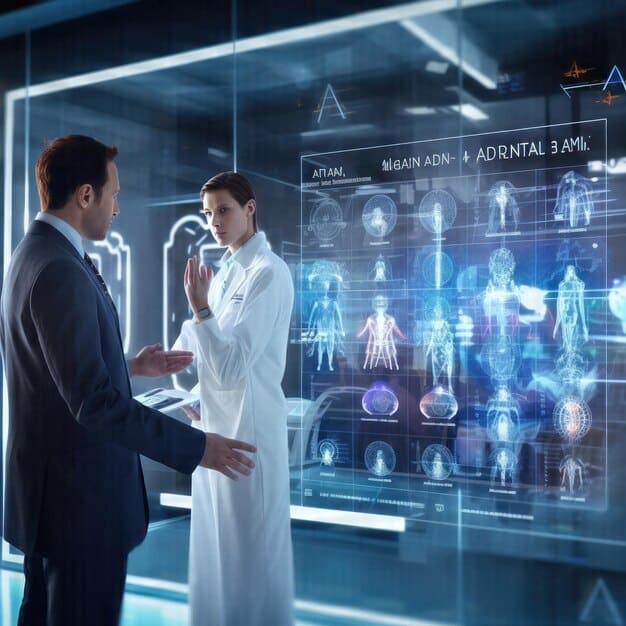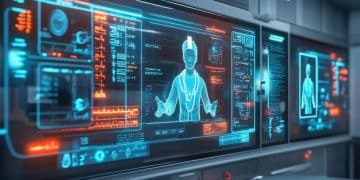AI-Powered Diagnostics Reshaping US Healthcare by 2025

Artificial intelligence will profoundly transform US healthcare diagnostics by 2025, enabling earlier disease detection, personalized treatment plans, and significantly enhanced operational efficiency, ultimately leading to improved patient outcomes and a more accessible healthcare system.
The landscape of healthcare is in constant evolution, driven by technological advancements. One of the most transformative innovations on the horizon is the integration of artificial intelligence (AI) into medical diagnostics. How will AI-powered diagnostics reshape US healthcare by 2025? This question is not merely academic; it delves into the very core of how diseases will be identified, treated, and managed in the near future, promising a paradigm shift for patients and practitioners across the nation.
The Dawn of Precision: AI in Medical Imaging and Pathology
The application of AI in medical imaging and pathology is perhaps the most immediate and impactful area where its transformative power is being felt. By 2025, AI algorithms will be indispensable tools, augmenting human capabilities in interpreting complex visual data from X-rays, MRIs, CT scans, and microscopic slides. These systems are designed to identify subtle patterns and anomalies that might elude the human eye, even that of a seasoned specialist.
AI’s strength lies in its ability to process vast datasets with unparalleled speed and accuracy. For instance, in radiology, AI can
quickly analyze thousands of scans to flag potential abnormalities, prioritizing cases that require immediate attention. This not only accelerates diagnosis but also reduces the cognitive load on radiologists, allowing them to focus on the most challenging interpretations and patient consultations.
Enhanced Detection and Early Intervention for Cancer
One of the most profound impacts of AI in diagnostics is in the early detection and characterization of cancer. AI models, trained on millions of historical images, can now detect cancerous lesions at nascent stages, often before they become clinically apparent. This
early intervention is critical, directly correlating with higher survival rates and less invasive treatment options.
- Mammography Analysis: AI systems show superior accuracy in detecting breast cancer from mammograms, reducing false positives and negatives.
- Pathology Slide Review: AI assists pathologists in identifying malignant cells on microscopic slides, improving diagnostic consistency.
- Prostate Cancer Diagnosis: AI can differentiate aggressive from indolent prostate cancer based on MRI scans, guiding treatment decisions.
The integration of these AI tools does not aim to replace human experts but rather to create a synergistic diagnostic team. Radiologists and pathologists will collaborate with AI, leveraging its analytical prowess to confirm findings, minimize errors, and deliver more precise diagnoses to patients. This co-pilot approach enhances confidence in diagnoses and streamlines workflows, setting a new standard for diagnostic excellence in US healthcare.
By 2025, the synergy between human expertise and AI’s analytical power will lead to a new era of diagnostic precision, where diseases like cancer are identified earlier and with greater accuracy, improving patient outcomes significantly.
Beyond Images: AI in Predictive Analytics and Risk Stratification
The scope of AI-powered diagnostics extends far beyond visual interpretation. Predictive analytics, driven by AI, is rapidly emerging as a critical tool for identifying individuals at high risk for various diseases even before symptoms manifest. By analyzing a plethora of patient data—including electronic health records (EHRs), genetic information, lifestyle factors, and environmental exposures—AI algorithms can forecast disease onset and progression with remarkable accuracy.
This proactive approach marks a significant shift from reactive medicine, where treatment begins only after symptoms appear, to preventative care. In a US healthcare system grappling with rising costs and the burden of chronic diseases, AI-driven predictive analytics offers a powerful solution to manage population health more effectively.
Personalized Medicine and Proactive Health Management
AI’s ability to process and correlate diverse data points enables the development of highly personalized risk profiles. For example, AI can analyze a patient’s genetic predisposition coupled with their lifestyle choices and medical history to predict their likelihood of developing conditions like type 2 diabetes, cardiovascular disease, or even certain autoimmune disorders.
- Cardiovascular Risk Assessment: AI models can predict heart attacks or strokes years in advance by analyzing ECGs, blood tests, and demographic data.
- Diabetes Prevention: Algorithms identify individuals at high risk for diabetes, allowing for early lifestyle interventions.
- Drug Response Prediction: AI can predict how a patient will respond to specific medications based on their genetic makeup, optimizing treatment plans.
Such predictions empower healthcare providers to intervene with targeted preventative measures, such as dietary advice, exercise regimens, or early pharmacological treatments. For patients, this means receiving personalized guidance that is tailored to their unique biological and environmental context, leading to better long-term health outcomes and a higher quality of life. The move towards personalized medicine, heavily reliant on AI, will be a defining characteristic of US healthcare by 2025.

The shift towards proactive health management, enabled by AI in predictive analytics, promises a future where diseases are not just treated but actively prevented, revolutionizing patient care in the US.
Operational Efficiency and Accessibility through AI
Beyond direct patient care, AI-powered diagnostics are poised to dramatically enhance the operational efficiency and accessibility of healthcare services across the US. The administrative burden and resource allocation challenges that currently plague the system can be significantly alleviated through AI automation and optimization. This translates into tangible benefits, from reducing wait times for diagnostic tests to making specialized care available in underserved areas.
By 2025, AI will not only streamline diagnostic processes but also contribute to a more equitable distribution of healthcare resources. This is particularly crucial in a country where healthcare disparities remain a significant concern, with rural populations and low-income communities often lacking access to advanced diagnostic facilities.
Streamlining Workflows and Reducing Costs
AI’s role in operational efficiency begins with automating routine tasks that consume valuable time for healthcare professionals. For instance, AI can manage appointment scheduling, process insurance claims, and even assist with preliminary patient triaging based on reported symptoms. This frees up human staff to focus on more complex tasks requiring critical thinking and direct patient interaction.
Furthermore, AI-driven diagnostics can reduce the need for expensive and invasive procedures by improving the accuracy of initial assessments. By correctly identifying conditions earlier and with fewer tests, healthcare systems can optimize resource utilization, leading to substantial cost savings. These savings can then be reinvested into other areas of patient care or used to expand access to services.
- Automated Data Entry: AI can extract relevant information from unstructured clinical notes, reducing manual data entry errors.
- Resource Optimization: AI models can predict equipment usage and patient flow, optimizing scheduling for MRI machines or operating rooms.
- Remote Diagnostics: AI-powered tools facilitate remote interpretation of diagnostic images, extending specialist care to rural clinics.
The advent of AI will also empower general practitioners with diagnostic capabilities previously reserved for specialists. For example, AI algorithms can help GPs interpret complex lab results or even basic medical images, allowing for quicker initial diagnoses and reducing the need for costly and time-consuming referrals. This decentralization of diagnostic expertise is vital for improving access to care in areas where specialists are scarce.
Ultimately, the enhanced operational efficiency and increased accessibility fostered by AI will lead to a more responsive, cost-effective, and patient-centric healthcare system in the US by 2025, ensuring that quality diagnostics are within reach for a broader population.
Challenges and Ethical Considerations in AI Implementation
While the promise of AI in reshaping US healthcare diagnostics is immense, its widespread implementation by 2025 is not without significant challenges and ethical considerations. These hurdles must be addressed proactively to ensure that AI technologies are adopted responsibly and equitably, maximizing their benefits while mitigating potential risks. Discussions around data privacy, algorithmic bias, and regulation are paramount.
The integration of AI into such a sensitive domain as healthcare demands rigorous oversight and a transparent framework to build trust among patients and healthcare providers alike. Without careful consideration, the very tools designed to improve health could inadvertently exacerbate existing inequalities or introduce new forms of harm.
Data Privacy, Security, and Algorithmic Bias
The foundation of effective AI diagnostics is vast amounts of patient data. This raises serious concerns about data privacy and security. Protecting sensitive health information from breaches and misuse is critical. Robust cybersecurity measures and strict adherence to regulations like HIPAA are essential. Patients must be assured that their data is handled with the utmost care and confidentiality.
Another major challenge is algorithmic bias. If AI models are trained on data sets that do not accurately represent the diverse US population—for example, if they primarily contain data from Caucasians—they may perform less accurately or even provide biased diagnoses for other ethnic or demographic groups. This can worsen health disparities and lead to misdiagnoses for underserved communities.
- Data Anonymization: Ensuring patient data is properly anonymized to protect identities during AI model training.
- Bias Detection: Developing and implementing methods to detect and correct algorithmic bias in diagnostic AI.
- Regulatory Frameworks: Establishing clear guidelines for the development, validation, and deployment of AI in healthcare.
Furthermore, the “black box” nature of some AI algorithms, where the decision-making process is not easily interpretable, presents a clinical challenge. Clinicians need to understand how an AI arrived at a particular diagnosis to trust it and to explain it to patients. The push for “explainable AI” (XAI) is vital to foster transparency and build confidence in these new diagnostic tools.
Addressing these challenges requires a collaborative effort from policymakers, healthcare institutions, AI developers, and patient advocacy groups. Only through thoughtful engagement with these ethical and practical considerations can the full potential of AI-powered diagnostics be safely and effectively realized in US healthcare by 2025.

Navigating the complex landscape of data privacy, algorithmic bias, and ethical oversight is crucial for the responsible and successful integration of AI into US healthcare diagnostics by 2025.
The Evolving Role of Healthcare Professionals
As AI-powered diagnostics become more prevalent by 2025, the roles of healthcare professionals will undoubtedly evolve. This transformation is not about replacement but rather a redefinition of responsibilities, emphasizing collaboration with AI systems, enhanced critical thinking, and a stronger focus on human-centric aspects of care. Clinicians will move from being solely data interpreters to becoming orchestrators of advanced diagnostic tools and patient navigators.
The integration of AI will free up valuable time previously spent on routine tasks, allowing professionals to dedicate more attention to complex cases, patient education, and intricate treatment planning. This shift promises a more fulfilling and impactful career for many in the healthcare sector.
New Skills and Collaborative Models
Healthcare professionals will need to develop new competencies to effectively utilize AI diagnostic tools. This includes understanding the capabilities and limitations of AI algorithms, interpreting AI-generated insights, and integrating these insights into comprehensive patient care plans. Training programs and continuous professional development will be crucial in equipping the workforce with these necessary skills.
Furthermore, new collaborative models will emerge, featuring multi-disciplinary teams composed of clinicians, AI specialists, data scientists, and ethicists. These teams will work together to ensure that AI tools are correctly applied, constantly monitored for performance, and continuously improved. The doctor-patient relationship will also evolve, with AI providing more robust information to facilitate shared decision-making.
- AI Literacy: Physicians and medical staff will need to be proficient in understanding AI diagnostic outputs.
- Patient Communication: Enhanced skills for explaining AI-assisted diagnoses to patients, ensuring comprehension and trust.
- Ethical Oversight: Professionals will play a key role in ensuring the ethical application of AI in clinical practice.
Nurses, for instance, might use AI-powered apps for preliminary patient assessments, identifying urgent cases or those requiring specialized attention more rapidly. General practitioners could leverage AI to cross-reference symptoms with vast diagnostic databases, enhancing their ability to identify rare conditions. Specialists, like radiologists, will use AI as a second pair of eyes, refining their accuracy and expediting their workflows.
The future of healthcare professionals in the age of AI will be characterized by a partnership between human expertise and machine intelligence, leading to more efficient, accurate, and compassionate care. This evolution will ensure that by 2025, US healthcare professionals are better equipped than ever to meet the complex demands of modern medicine.
The Patient Experience: A New Era of Empowerment
Central to the advancements in AI-powered diagnostics is the profound impact on the patient experience. By 2025, patients in the US will likely encounter a healthcare system that is more responsive, personalized, and transparent, largely due to the integration of AI. This shift promises to empower individuals with greater control over their health journeys, offering earlier insights and more tailored interventions than previously imagined.
The fear of the unknown, often associated with delayed diagnoses or generalized treatment plans, will begin to dissipate as AI provides more precise and timely information, fostering a new era of patient engagement and confidence.
Faster, More Accurate, and Accessible Diagnoses
For patients, one of the most immediate benefits of AI-powered diagnostics will be significantly reduced wait times for diagnostic results. AI’s ability to quickly process and analyze complex data means that diagnoses can be rendered faster, alleviating anxiety and enabling quicker initiation of treatment. This is particularly crucial for critical conditions where time is of the essence.
Furthermore, the enhanced accuracy of AI-driven diagnostic tools will lead to fewer misdiagnoses and a reduction in the need for repeat testing. Patients can have greater confidence in the initial diagnosis, leading to more effective treatment paths and avoiding unnecessary procedures. The accessibility of these advanced diagnostic capabilities, even in remote areas through telemedicine enhanced by AI, means that more people will have access to high-quality care, regardless of their location.
- Reduced Anxiety: Faster and more accurate diagnoses mean less time spent waiting and worrying about health conditions.
- Personalized Communication: AI can help tailor health information, making it easier for patients to understand their conditions and treatment options.
- Proactive Health Monitoring: Wearable devices integrated with AI will provide continuous health monitoring and early alerts for potential issues.
Patients will also benefit from highly personalized treatment recommendations derived from AI analysis of their unique medical profiles. Instead of a one-size-fits-all approach, AI can identify the most effective therapies based on genetic markers, lifestyle data, and responses to previous treatments. This leads to better outcomes and a more efficient use of healthcare resources, as treatments are precisely matched to individual needs.
By 2025, the patient experience in US healthcare will be characterized by greater empowerment, faster diagnoses, more accurate insights, and highly personalized care plans, fundamentally transforming how individuals interact with and benefit from the medical system.
Regulatory Landscape and Future Outlook
The rapid advancement of AI in healthcare diagnostics necessitates a robust and adaptive regulatory landscape to ensure safety, efficacy, and public trust. By 2025, the US Food and Drug Administration (FDA) and other regulatory bodies will have established more refined frameworks specifically addressing AI-powered medical devices and algorithms. This foundational oversight is crucial for fostering innovation while simultaneously protecting patient interests.
The future outlook for AI in US healthcare diagnostics is overwhelmingly positive, contingent upon the successful navigation of these regulatory challenges and a continued commitment to ethical development. The benefits of improved patient outcomes and systemic efficiency are too significant to ignore.
Adapting Regulations for Dynamic AI Systems
One of the unique challenges with AI in diagnostics is the “adaptive” nature of some algorithms, which can continuously learn and evolve from new data. Traditional regulatory approval pathways are designed for static medical devices. Regulators are actively working on innovative approaches, such as “predetermined change control plans,” to allow for ongoing learning and updates to AI models while ensuring their safety and performance remain within acceptable limits.
The FDA has already begun to issue guidance documents and approvals for AI/Machine Learning-based medical devices, signaling a proactive stance. By 2025, we can expect a clearer and more streamlined process for bringing AI diagnostic tools to market, encouraging further investment and development in this critical area.
- FDA Guidance: Expect more specific guidelines for AI/ML-based SaMD (Software as a Medical Device) approvals.
- International Harmonization: Efforts to align regulatory standards with global bodies to facilitate broader adoption and innovation.
- Real-World Evidence: Increased emphasis on post-market surveillance and real-world data collection to monitor AI performance.
Beyond regulatory approval, the broader integration of AI will also require attention to reimbursement policies. Insurers and Medicare/Medicaid will need to develop clear guidelines for covering AI-powered diagnostic services, ensuring that these advanced tools are accessible to all eligible patients and not just a privileged few. Economic models must adapt to value-based care, recognizing the long-term cost savings and improved outcomes that AI can provide.
The regulatory landscape for AI in US healthcare diagnostics by 2025 will be more mature and supportive of innovation, balancing the need for rapid advancement with unwavering commitments to patient safety and ethical practice. The collaborative efforts of government, industry, and academia will pave the way for a future where AI is a deeply embedded and trusted component of medical care.
| Key Aspect | Brief Description |
|---|---|
| 🔬 Enhanced Diagnostics | AI will significantly improve accuracy and speed in imaging and pathology, leading to earlier disease detection. |
| 📈 Predictive Analytics | AI will enable proactive health management by predicting disease risk and personalizing prevention strategies. |
| ⚙️ Operational Efficiency | Automation of tasks and improved resource allocation will lead to more accessible and efficient healthcare. |
| 🛡️ Ethical & Regulatory Focus | Addressing data privacy, bias, and regulatory frameworks is crucial for trustworthy AI implementation. |
Frequently Asked Questions About AI in Healthcare Diagnostics
No, not by 2025. AI is expected to augment, not replace, human doctors. It will serve as a powerful tool to assist clinicians in areas like image analysis and data interpretation, freeing them to focus on complex decision-making, patient interaction, and personalized care. AI will enhance diagnostic accuracy and efficiency, improving the overall capabilities of medical professionals.
AI can significantly improve diagnostic accuracy for rare diseases by analyzing vast amounts of medical literature, patient records, and genetic data at speeds humans cannot match. It can identify subtle patterns and correlations that might indicate a rare condition, offering potential diagnoses for doctors to investigate further, ultimately reducing diagnostic delays for affected patients.
Major concerns include data privacy and security, as AI relies on sensitive patient information. Algorithmic bias, which could lead to misdiagnoses for certain demographic groups, is another critical issue. Trust and ethical oversight are also paramount, requiring transparent AI models and robust regulatory frameworks to ensure responsible and equitable adoption.
Absolutely. AI excels at processing complex diagnostic data, including genetic profiles, medical history, and real-time biometric information, to formulate highly personalized treatment plans. By identifying optimal therapies based on individual patient characteristics, AI can significantly improve treatment efficacy, minimize side effects, and contribute to better patient outcomes by 2025.
AI is expected to enhance patient access by streamlining diagnostic workflows, reducing costs, and enabling remote diagnostic capabilities. It can help balance the distribution of specialized care, making high-quality diagnostics available in underserved and rural areas through telemedicine and local clinics, thereby narrowing existing healthcare equity gaps by 2025.
Conclusion
By 2025, AI-powered diagnostics will have deeply integrated into the fabric of US healthcare, driving an unprecedented transformation. From revolutionizing medical imaging and pathology with enhanced precision to enabling proactive, personalized medicine through predictive analytics, AI promises a future of earlier disease detection, more effective treatments, and significantly improved patient outcomes. While challenges such as data privacy, algorithmic bias, and the evolving roles of healthcare professionals require careful navigation, the trajectory is clear: AI will empower both clinicians and patients, making healthcare more efficient, accessible, and ultimately, more human-centric. The shift towards a smarter, more responsive diagnostic ecosystem is not just an aspiration but a rapidly approaching reality, ensuring a healthier future for all Americans.





